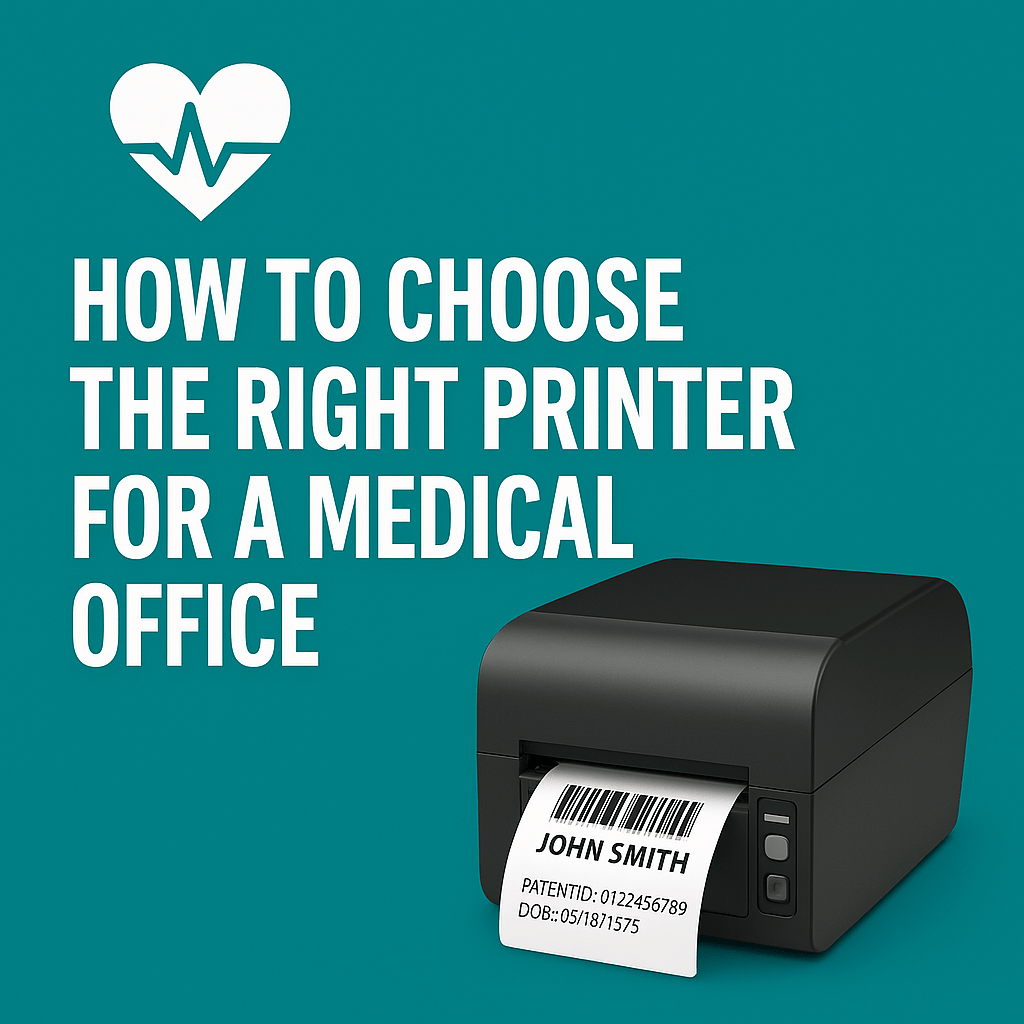Choosing the right printer for a medical office is more important than most people realize. From patient labels and prescription scripts to specimen labeling tubes, charts, wristbands, and insurance forms, the wrong printer can slow down workflows and even create safety risks. Medical offices need printing technology that is fast, reliable, clean, and built for clinical environments.
This guide breaks down exactly what to look for, the types of printers used in healthcare, and real-world recommendations based on staff workflows.
Why Printer Choice Matters in Medical Settings
Unlike regular offices, medical facilities require printing that is:
• Smudge-proof and resistant to alcohol wipes
• Accurate for barcodes and patient identifiers
• Fast enough for high-traffic reception and exam rooms
• Durable for long shifts and constant use
• Compatible with EHR, EMR, LIS, and pharmacy software
A slow or unreliable printer disrupts patient flow, increases labeling mistakes, and creates administrative bottlenecks.
Inkjet vs Thermal Printers: Which Works Better in a Medical Office?
Most medical offices no longer use inkjet or laser printers for labeling, because:
• Ink smears when exposed to disinfectants
• Cartridges dry out
• Printing is slower
• Long-term costs are higher
Medical environments overwhelmingly prefer thermal printers because they print fast, clean, and without ink or toner.
Direct Thermal (DT printers)
✓ No ink or toner
✓ Great for wristbands, patient labels, prescription labels, visitor badges
✓ Ideal for short-term clinical use
Thermal Transfer (TT printers)
✓ Uses resin ribbons for extra durability
✓ Best for long-term medical records, freezer labels, and sample storage
Key Features to Look For in a Medical Office Printer
Below are the most important features buyers should consider.
1. Print Technology
Choose based on the type of labels your office uses:
• Direct thermal for daily clinical printing
• Thermal transfer for long-term or freezer labeling
• High DPI (300 dpi) for small barcodes, medication labels, specimen tubes
2. Speed and Throughput
A medical office cannot wait 10 seconds per label.
Look for:
• 4–6 inches per second (IPS) minimum
• High-capacity rolls for fewer changes
• Fast first-label-out time
3. Durability and Clinical Safety
Your printer should withstand:
• Long shifts
• Alcohol wipes
• Continuous use
• Emergency labeling situations
Healthcare-grade GoDEX printers come with a 3-year warranty, which is one of the strongest in the industry.
4. Media Compatibility
A medical office often prints:
• Patient wristbands
• Chart labels
• Prescription labels
• Specimen tubes
• File folder labels
• Visitor badges
Choose a printer that handles multiple media types without jams or alignment issues.
5. Software Integration
Compatibility is critical. Look for printers that work easily with:
• EPIC
• Cerner
• Athenahealth
• eClinicalWorks
• MEDITECH
• Pharmacy systems
• LIS / lab software
Most GoDEX printers integrate through standard drivers (ZPL, EPL, etc.).
6. Compact Size for Tight Spaces
Reception desks, nurse stations, and exam rooms have limited space.
Compact thermal printers are preferred because they:
• Fit on narrow counters
• Operate quietly
• Don’t require ink storage
7. Ease of Use for Staff
Medical staff should not spend time troubleshooting printers.
Look for:
• Drop-in label loading
• Clear status indicators
• Simple buttons
• Plug-and-play USB connection
Recommended Printers for Medical Offices (Based on Workflow)
Here are the strongest options for each use case:
Best for Patient Labels, Scripts, and Daily Use
Ideal for reception desks, check-in, medication labels, and general labeling.
Best for Hospital / Clinic Labeling
Compact, quiet, and perfect for admin + clinical overlap.
Best for Wristbands & Bedside Labeling
Designed specifically for medical wristband media.
Best for Mobile Specimen Collection
Portable, lightweight, ideal for home healthcare, ER, and ambulatory care.
Best for Automated Tube Labeling
For tubes 0.5–50 mL. High accuracy and ideal for labs.
How to Match the Printer to Your Medical Office Type
Primary Care / Family Medicine
DT4x or DT200i
Handles all core labeling: folders, samples, prescriptions, forms.
Pediatrics
DT2x or DT4x
Great for wristbands, small charts, and allergy alerts.
Specialty Clinics (ENT, oncology, dermatology)
DT4x
High-precision barcodes and specimen labeling.
Outpatient Labs or Phlebotomy Areas
GTL-100 or MX30i
Accurate specimen labeling is essential for safety.
Urgent Care / Walk-In Clinics
DT200i / DT4x
Fast, durable, zero-maintenance technology is needed.
Common Mistakes When Choosing a Medical Office Printer
❌ Choosing inkjet because it’s cheaper initially
❌ Not verifying compatibility with EMR/EHR systems
❌ Buying a printer that cannot handle wristbands
❌ Using office printers for specimen tubes
❌ Ignoring DPI requirements for small barcodes
❌ Forgetting about the total cost of ownership
Final Recommendations
For 90 percent of medical offices, a thermal printer is the best solution.
It’s reliable, maintenance-free, healthcare-safe, and faster than any ink-based system.
If you need one printer to handle most tasks, choose:
⭐ GoDEX DT4x
If you need wristbands, reception labels, and folders:
⭐ GoDEX DT200i
For labs and specimen labeling:
⭐ GoDEX GTL-100 or ⭐ MX30i
All GoDEX printers include a 3-year warranty, making them one of the strongest long-term investments in healthcare printing.

